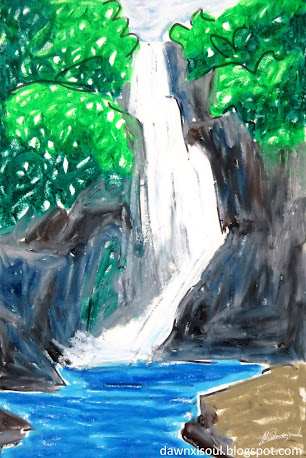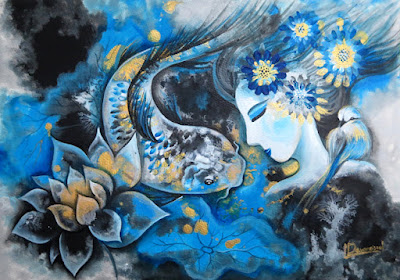June 24 (Lunar calendar: May 7), 2023 Saturday | Dawnxisoul393art
The Thoughts after Watching the Film《1917》:
Today we watched the American DreamWorks production, "1917", a war film directed by Sam Mendes and starring George McKay and Dean Charles Chapman. More than 100 years ago, in 1914, Archduke Ferdinand, crown prince of the Austro-Hungarian Empire, was assassinated by a Serbian hot-blooded youth named Cabrillo princip on his way to Sarajevo. The death of Archduke Ferdinand ignited the long explosive European continent and then spread into the first World War in human history. The film tells the story of two British soldiers who ventured across enemy territory to deliver vital information to save 1,600 lives during the First World War. In the spring of “1917”, during World War I, the German army retreated from the battlefield to the Hindenburg Line, where mines and snipers were set as traps. After a long standoff with the Germans, a British unit seemed to find an opportunity to destroy the Germans and planned to attack the German lines. By the end of the day, the British commander General realized that this was a trap set by the Germans, but could no longer contact this British unit.
War is the highest form after the intensification of contradictions and an extended-expression of politics, but this does not mean that individuals in the war have deep hatred or clear political demands. In 1917, the war had been going on for three years. Two 16-year-old British soldiers had to cross the dead zone and save 1600 people. Such a story was reconstructed by "007 professional" and director Sam Mendes, organized into the most beautiful expression in war films in the new century, and successfully won three awards of the best photography, mixing, and visual effect in the 92nd Oscar. We “experienced” and “participated” in the war, but we are destined to be just the followers behind the soldiers. On the battlefield, in order to find the Colonel as soon as possible, The protagonist runs desperately. There is a shocking crisscross between an individual running to save people and countless individuals attacking for war. The protagonist's rampage in spite of his life brings raw and full emotional tension.
This long shot can be said to be full of meaning and deep emotion. We need to acknowledge the high level of play of this film in terms of technical difficulty in tapping. In order to ensure the continuity of the lens as much as possible, the main creators of the film have created about 5200 feet of real trenches and rich battlefield scenes, and cleverly connected them seamlessly with puddles and rivers. As for the meantime, it took months to rehearse just the positions of the actors and the path of the camera. Super high demand for accurate interpretation and high obedience from the top to the main characters, down to the mass actors, and also showed the rigor and seriousness of the creators. This "one mirror to the end" must be "perfect". Any small defect may cause terrible waste and delay. Just like the extraordinary tasks performed by the two soldiers, it can't be repeated for once. “1917”, is not too much to call it a "visual spectacle". The film uses a black screen in midfield to break the continuity of time and viewpoint, so it is divided into upper and lower parts.
The first half, a thriller road film, emphasizing the following attributes, the second half, a war lyric film, focusing on emotional support. At the beginning of the mission, there are two groups performing the mission: two soldiers and us - the audience. We are "in" all positions of the team and work with them "to unfold this war scroll". This multi-angle following lens gives the audience a great sense of immersion. We need to grope forward constantly and carefully, explore the surrounding environment and be alert to dangers at all times. At this time, the fun and participation of discovery have been greatly improved. It is true that the camera of “1917” has always followed the two messenger soldiers, from a leisurely afternoon in early spring to a cruel war. The visual coherence gives us a feeling that we followed the soldiers personally.
Illustrated by dawnxisoul393
The film has to consider, in addition to completing a one-time shot, the content of the film to be shown, the change of light within the shot. From the perspective of film aesthetics, "one shot to the end" is a kind of shot language opposed to montage, which emphasizes the continuity and authenticity of time and space. "One shot to the end", keeping the timeline of the film synchronized with the timeline of our reality so that people forget the existence of the camera and immerse themselves in the first-person perspective of the protagonist to achieve the best viewing experience of forgetting oneself. Director Sam Mendes admitted in an interview that, "The shooting difficulty of "1917" is five times that of an ordinary film". The first is the cooperation of the whole film team, which is accurate to seconds. Just one wrong line, or a blast that happens one-second slower, will require a complete do-over. But as a film director with artistic pursuits, completing a film with "one shot to the end" is like the satisfaction and glory a runner feels when he finishes a marathon.
The second is the ultra-high requirements of the cameraman, he needs to be familiar with each scene, even specific to each frame, the camera position deployment, as well as skilled switching between different scenes, to do when overhead, flat, overhead, elevation, rotation, wide-angle, panoramic, medium, close-up all know. As a "road film" in the war theme, “1917” involves many and complex scenes, including war destroyed towns, enemy trenches, wild rivers, forests and waterfalls, war front lines, etc. in order to maintain the continuity of the lens, it is inevitable for the cameraman to be hung in the air, and the difficulty is unimaginable. From the skeletal corpses on the battlefield to the woman holding her baby in the basement to the two soldiers arguing over whether to save the German pilot. The quiet singing of the soldiers in the woods, the brilliant cherry trees, cruel and beautiful images were included in the camera by the director with ingenious techniques.
In fact, the director's emotion has been very delicate, but the emotional delicacy is different from the characterization. The most important basis for us to judge whether a character is well portrayed is whether the character is three-dimensional. We see an important change in the protagonist in the film. We see an important transformation of the main character in the film, from the original fear, after experiencing the harsh reality of the sacrifice of his comrades, apparently firming up the belief that he must bring the message to his destination. The camera follows the protagonist and we experience together. Looking around, we are sentinels. The tense emotion and emotional maintenance in the whole path have also been fully amplified, forming a subjective feeling different from that created by other narrative skills. After the black screen, we wake up together. The time and place are blurred, leaving only the ruins composed of flames and flares outside the window, just like stepping into the edge of strange hell. The long lens brings this illusory and real light and shadow effect to the extreme: the church under the fire forms a strong visual contrast with the lonely silhouette of the protagonist.
Illustrated by dawnxisoul393
At this time, another lonely figure slowly came across. He began to run. He picked up the gun, the bullet came out of the chamber... Then the camera began to deliberately reduce the followability, gradually releasing the third pair of eyes, giving us a broad moment to observe and experience - the flowing water, the floating bodies, the breeze, the sky, the falling leaves. Finally, we have a change in narrative perspective, we are no longer part of the mission team and return to the identity of the witnesses of the event. At the end of the film, the protagonist sits by the tree, just like in the beginning. At this moment, we are as tired as him... But our mood is different at this time. Director, with persistent courage, presented this epic for us, this poetic visual war film, the film full of sincerity and love.
Watching “1917” objectively is indeed an excellent film and a work worth watching, because it is a film that allows us to look forward to beauty in disaster. In 2020 and 2021, we experienced an epidemic. Looking back on the dizzy accidents in our lives, such as the accident of breaking our legs and the tension when submitting our master's doctoral thesis, we suddenly feel how happy and smooth it was at that time.
Original by dawnxisoul393













Comments
Post a Comment